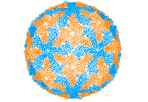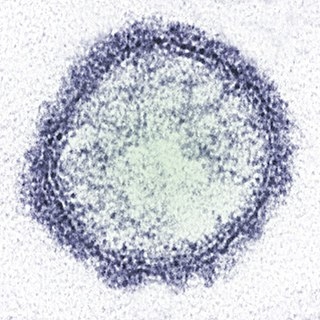
Bunyavirales is an order of segmented negative-strand RNA viruses with mainly tripartite genomes. Member viruses infect arthropods, plants, protozoans, and vertebrates. It is the only order in the class Ellioviricetes. The name Bunyavirales derives from Bunyamwera, where the original type species Bunyamwera orthobunyavirus was first discovered. Ellioviricetes is named in honor of late virologist Richard M. Elliott for his early work on bunyaviruses.

Viral hemorrhagic fevers (VHFs) are a diverse group of animal and human illnesses in which fever and hemorrhage are caused by a viral infection. VHFs may be caused by five distinct families of RNA viruses: the families Filoviridae, Flaviviridae, Rhabdoviridae, and several member families of the Bunyavirales order such as Arenaviridae, and Hantaviridae. All types of VHF are characterized by fever and bleeding disorders and all can progress to high fever, shock and death in many cases. Some of the VHF agents cause relatively mild illnesses, such as the Scandinavian nephropathia epidemica, while others, such as Ebola virus, can cause severe, life-threatening disease.

Tick-borne encephalitis virus (TBEV) is a positive-strand RNA virus associated with tick-borne encephalitis in the genus Flavivirus.

Crimean–Congo hemorrhagic fever (CCHF) is a viral disease. Symptoms of CCHF may include fever, muscle pains, headache, vomiting, diarrhea, and bleeding into the skin. Onset of symptoms is less than two weeks following exposure. Complications may include liver failure. In those who survive, recovery generally occurs around two weeks after onset.

Thogotovirus is a genus of enveloped RNA viruses, one of seven genera in the virus family Orthomyxoviridae. Their single-stranded, negative-sense RNA genome has six or seven segments. Thogotoviruses are distinguished from most other orthomyxoviruses by being arboviruses – viruses that are transmitted by arthropods, in this case usually ticks. Thogotoviruses can replicate in both tick cells and vertebrate cells; one subtype has also been isolated from mosquitoes. A consequence of being transmitted by blood-sucking vectors is that the virus must spread systemically in the vertebrate host – unlike influenza viruses, which are transmitted by respiratory droplets and are usually confined to the respiratory system.

Orbivirus is a genus of double-stranded RNA viruses in the family Reoviridae and subfamily Sedoreovirinae. Unlike other reoviruses, orbiviruses are arboviruses. They can infect and replicate within a wide range of arthropod and vertebrate hosts. Orbiviruses are named after their characteristic doughnut-shaped capsomers.

Orthonairovirus is a genus of viruses in the family Nairoviridae of the order Bunyavirales that include viruses with circular, negative-sense single stranded RNA. It got its name from the Nairobi sheep disease that affects the gastrointestinal tracts of sheep and goats. The vast majority, and perhaps all viruses in this genus are tick-borne viruses that can have human or other vertebrate hosts.

Orthobunyavirus is a genus of the Peribunyaviridae family in the order Bunyavirales. There are currently ~170 viruses recognised in this genus. These have been assembled into 103 species and 20 serogroups.
Bunyamwera orthobunyavirus (BUNV) is a negative-sense, single-stranded enveloped RNA virus. It is assigned to the Orthobunyavirus genus, in the Bunyavirales order.
Toscana phlebovirus (TOSV) is an arbovirus belonging to Bunyavirales, an order of negative-stranded, enveloped RNA viruses. The virus can be transmitted to humans by the bite of an infected sandfly of the genus Phlebotomus. Toscana is not normally associated with disease, as indicated by high seroprevalence rates in endemic areas, but in common with other sandfly transmitted viruses such as Naples virus and Sicilian virus, infection may result in Pappataci fever, an illness with mild fever, headache and myalgia. In serious cases that go undiagnosed, acute meningitis, meningoencephalitis and encephalitis may occur. There is no specific treatment for infection, so treatment is supportive, reducing the severity of symptoms until the immune system has cleared the infection.
Dabie bandavirus, also called SFTS virus, is a tick-borne virus in the genus Bandavirus in the family Phenuiviridae, order Bunyavirales. The clinical condition it caused is known as severe fever with thrombocytopenia syndrome (SFTS). SFTS is an emerging infectious disease that was first described in northeast and central China 2009 and now has also been discovered in Japan, South Korea, Vietnam and Taiwan in 2015. SFTS has a fatality rate of 12% and as high as over 30% in some areas. The major clinical symptoms of SFTS are fever, vomiting, diarrhea, multiple organ failure, thrombocytopenia, leukopenia and elevated liver enzyme levels. Another outbreak occurred in East China in the early half of 2020.

Schmallenberg orthobunyavirus, also called Schmallenberg virus, abbreviated SBV, is a virus that causes congenital malformations and stillbirths in cattle, sheep, goats, and possibly alpaca. It appears to be transmitted by midges, which are likely to have been most active in causing the infection in the Northern Hemisphere summer and autumn of 2011, with animals subsequently giving birth from late 2011. Schmallenberg virus falls in the Simbu serogroup of orthobunyaviruses. It is considered to be most closely related to the Sathuperi and Douglas viruses.
Sangassou orthohantavirus(SANGV) is single-stranded, negative-sense RNA virus species of the genus Orthohantavirus in the Bunyavirales order. It was first isolated in an African wood mouse in the forest in Guinea, West Africa in 2010. It is named for the village near where the mouse was trapped. It is the first indigenous Murinae-associated African hantavirus to be discovered.
Naples phlebovirus is an antigenic species of genus Phlebovirus within the family Phenuiviridae of the order Bunyavirales. It is an enveloped RNA virus with a tripartite genome e Uukuniemi (UUK) serogroup. The Sandfly group's natural reservoir are sandflies, while the natural reservoir for Uukuniemi is ticks. The SFNV serogroup consists of two main serocomplexes associated with disease in humans, the Naples and Sicilian serocomplexes. Sandfly fever induces myalgia, fever, and elevated liver enzymes in humans. It is difficult to diagnose outside endemic areas.
Tahyna orthobunyavirus ("TAHV") is a viral pathogen of humans classified in the California encephalitis virus (CEV) serogroup of the Orthobunyavirus family in the order Bunyavirales, which is endemic to Europe, Asia, Africa and possibly China.
Batai orthobunyavirus (BATV) is a RNA virus belonging to order Bunyavirales, genus Orthobunyavirus.
Cache Valley orthobunyavirus (CVV) is a member of the order Bunyavirales, genus Orthobunyavirus, and serogroup Bunyamwera, which was first isolated in 1956 from Culiseta inornata mosquitos collected in Utah's Cache Valley. CVV is an enveloped arbovirus, nominally 80–120 nm in diameter, whose genome is composed of three single-stranded, negative-sense RNA segments. The large segment of related bunyaviruses is approximately 6800 bases in length and encodes a probable viral polymerase. The middle CVV segment has a 4463-nucleotide sequence and the smallest segment encodes for the nucleocapsid, and a second non-structural protein. CVV has been known to cause outbreaks of spontaneous abortion and congenital malformations in ruminants such as sheep and cattle. CVV rarely infects humans, but when they are infected it has caused encephalitis and multiorgan failure.
The Punta Toro virus is a member of the genus Phlebovirus of the order Bunyavirales. It was initially isolated from patients in Colombia and two key patients in Panama. Two individual serotypes of PTV were isolated from these patients, PTV-Adames (A) and PTV-Balliet (B), with PTV-A appearing to be more virulent. PTV is considered to be relatively contained to the Americas with no cases being reported outside of this region. Along with a few other human pathogenic Phleboviruses, PTV is considered to be a significant virus in terms of public health as little information is known about its clinical effects and with further research underway, PTV could have unforeseen impacts on health and virology.
The Tofla virus is a strain of Hazara orthonairovirus in the genus Orthonairovirus belonging to the Crimean-Congo hemorrhagic fever serogroup. It was isolated from Ixodid in Japan in 2016.
Bunyaviridae nonstructural S proteins (NSs) are synthesized by viral DNA/RNA and do not play a role in the replication or the viral protein coating. The nonstructural S segment (NSs) created by Bunyaviridae virus family, are able to interact with the human immune system, in order to increase their replication in infected cells. Understanding this mechanism can have global health impacts.








